To understand public opinion on child adoption and identify potential barriers and needs in this area, at the beginning of 2024, the KSE Institute and the research agency Info Sapiens conducted a nationwide representative sociological survey with the support of UNICEF. The aim of this survey is to assess the population’s perception of state social policy, determine the need for social services, and clarify Ukrainians’ attitudes toward child adoption and their readiness for it. A total of 2,047 respondents aged 18 and older participated in the survey.
The issue of adoption and providing temporary care for children is becoming particularly urgent in Ukraine, as children are losing their parents due to active hostilities, regular missile strikes, and other attacks across the country.
According to the National Social Services of Ukraine, as of July 2024, 11,700 children have lost their parents and become orphans due to the conflict. By the end of 2023, over 66,000 children in Ukraine were orphans or deprived of parental care. Of these, nearly a quarter are in need of a new permanent family, such as through adoption.
With the onset of full-scale war, the number of people willing to adopt a child has doubled. By July 2024, there were 2,112 registered adoption applicants compared to 1,079 in 2021. However, the number of actual adoptions has decreased: in 2021, Ukrainians and foreigners adopted 1,354 children, while in 2023, the number of adopted children was 31.5% lower, at only 927. This decrease in adoptions is due to the fact that child adoption during the war is only possible in regions without active hostilities and where government authorities are functioning normally. Additionally, since 2022, only Ukrainian citizens registered as candidates for adoption and living in areas controlled by Ukraine can adopt children. During martial law, foreign adoption is not allowed. This decision was likely made to protect children’s rights and prevent potential risks of them being taken outside Ukraine. Amid a demographic crisis, as Ukraine’s population declines due to war and emigration, the government is working to ensure that children remain in the country.
Figure 1. Number of adopted children and children in need of adoption compared to the number of prospective adoptive parents, persons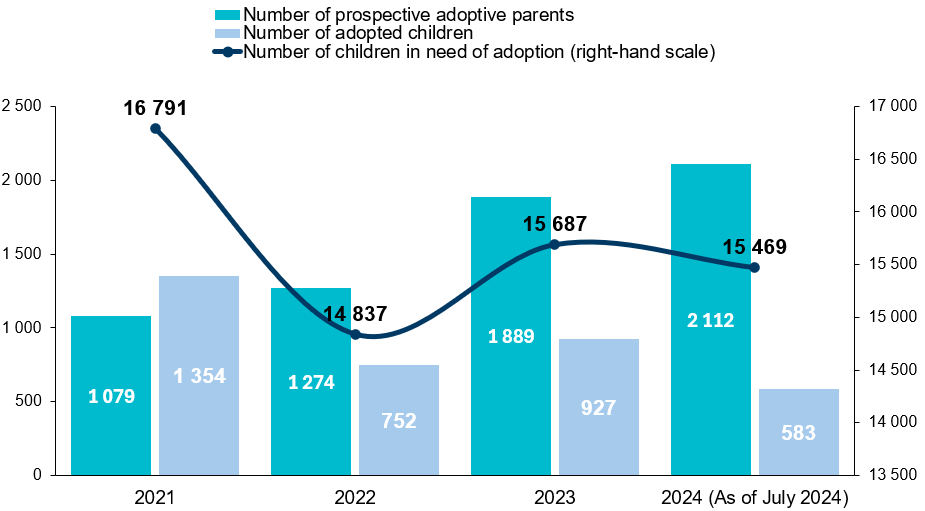
Source: National Social Service of Ukraine
Among all the children in need of a family, 10% (1,500 children) have disabilities. The number of adopted children with disabilities in Ukraine has decreased by 4.5 times. There were over 90 adoptions per year in 2020-2021, but this number dropped to just 22 children in 2023 (Figure 2).
Figure 2. Number of adopted children with disabilities and children with disabilities in need of adoption, persons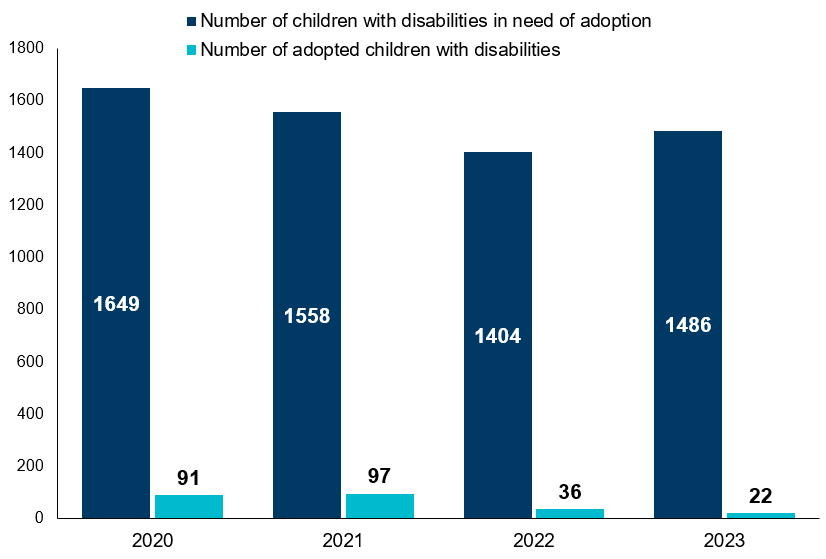
Source: National Social Service of Ukraine
Willingness to adopt
The survey results showed that the willingness to adopt among respondents is generally low. Only 3% consider the possibility of adopting a child, and another 1% have already adopted or are in the process of adopting. Nearly 17% had previously thought about adoption but decided against it, with this refusal being more common among those with children aged 15-17 (23%). However, a quarter of respondents are open to considering adoption in the future, with this willingness significantly higher among younger respondents: 45% among those aged 18-29 and 29% among those aged 30-44. Half of the respondents (50%) have never thought about adopting a child and do not plan to do so.
Willingness to adopt decreases with respondents’ age. Most individuals aged 45-59 (59%) and over 60 (71%) do not plan to adopt children. Thus, younger respondents are more open to the idea of adoption. 12% of respondents cited age as a reason for refusing to adopt. Among those aged 45-59, this figure was 22% among those over 60, it was 46%.
Figure 3. Attitudes toward adoption and intentions among people aged 18-59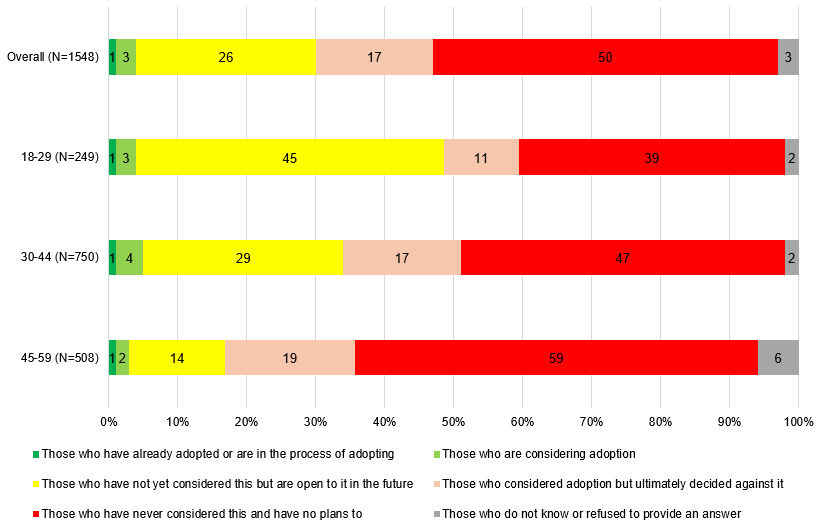
The most common reason for refusing to adopt is having biological children (50%), particularly among those who have never considered adoption (59%). Financial difficulties are a significant barrier for 18% of respondents, and this issue is more prevalent among those who considered adoption but ultimately declined (23%).
Figure 4. Reasons for the lack of intention to adopt a child among those who considered adoption but decided against it and those who never planned to adopt (N=1034)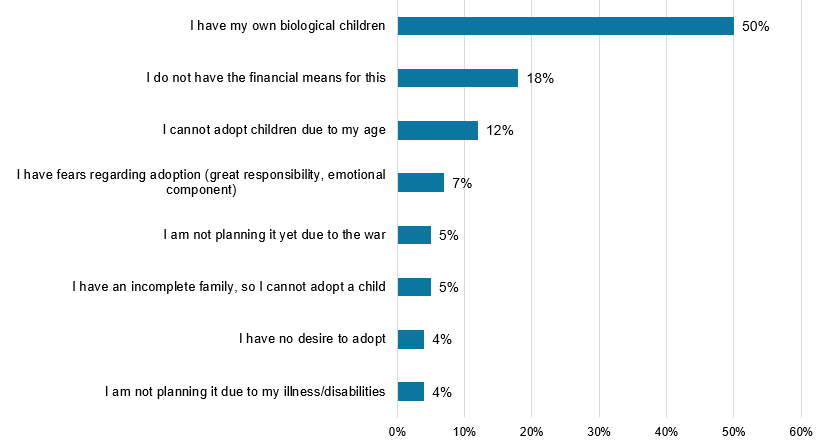
Factors that motivate people to adopt a child
More than half of the respondents (56%) believe that the decision to adopt is often influenced by the inability to have biological children or other obstacles to natural childbirth. This opinion is more commonly expressed by those who have not thought about adoption but are willing to consider it in the future (64%).
Four in ten respondents (41%) indicate that financial capability to support an adopted child is an important factor. Additionally, 39% note that the desire to provide a home for a child in need motivates or could motivate them. This factor is particularly significant for those who considered adoption but changed their minds (50%) and for those who have not yet thought about adoption but are open to it in the future (49%).
Figure 5. Factors that respondents believe influence the decision to adopt a child (N=2047)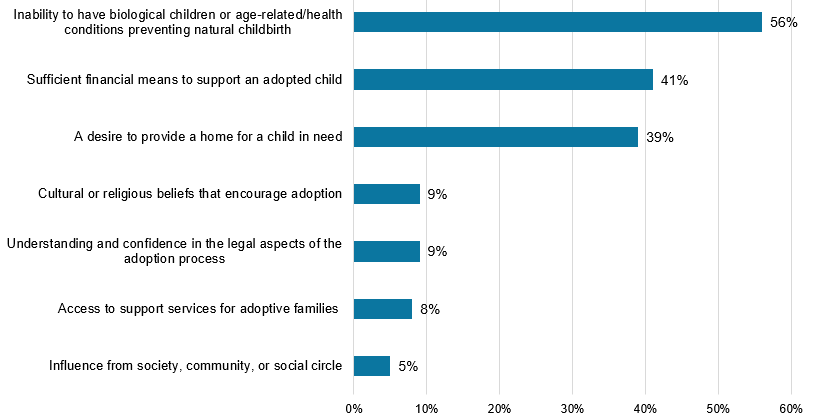
Among respondents considering the possibility of adoption, one-third indicated that medical and psychological support during and after adoption would be helpful. Another third requires financial assistance, and 13% consider legal support to be important.
Willingness to adopt a child with disabilities
Among those considering the possibility of adoption now or in the future, one in five (20%) is willing to adopt a child with disabilities. Households with individuals with disabilities show a higher willingness to adopt children with disabilities (30%) compared to households without individuals with disabilities (17%). People aged 18-29 are more inclined to adopt a child with disabilities (27%) than respondents aged 30-59 (16-17%).
Figure 6. Willingness to adopt a child with disabilities among those considering adoption or open to it in the future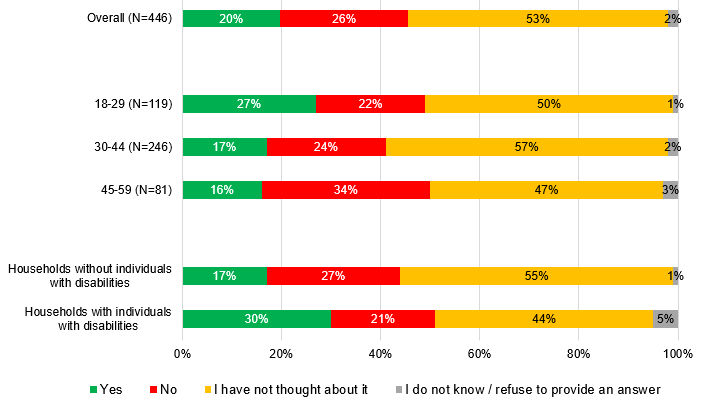
Barriers to the adoption process
According to respondents’ assessments, the main barriers to adoption are a complicated bureaucratic process (44%), lack of financial resources (34%), and insufficient information about the adoption process and potential government support (22%).
Figure 7. Key barriers to child adoption, according to respondents’ assessments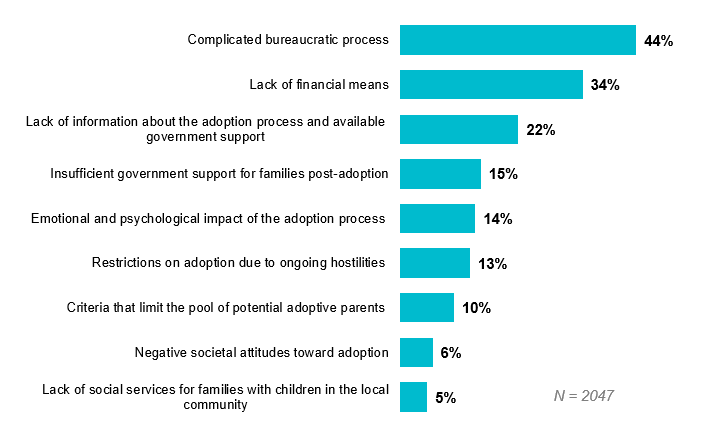
Awareness of government support
The survey results revealed low awareness among respondents regarding government support for adoptive parents. Among those with no adoption experience, only 7% are aware of government support for those adopting children, while 28% are partially informed about it. Most of those partially informed mentioned monetary payments (72%), 20% noted benefits and subsidies, and 18% mentioned housing support (although, in reality, there are no specific housing benefits for adoptive parents in Ukraine).
Figure 8. Awareness of forms of government support for adoptive parents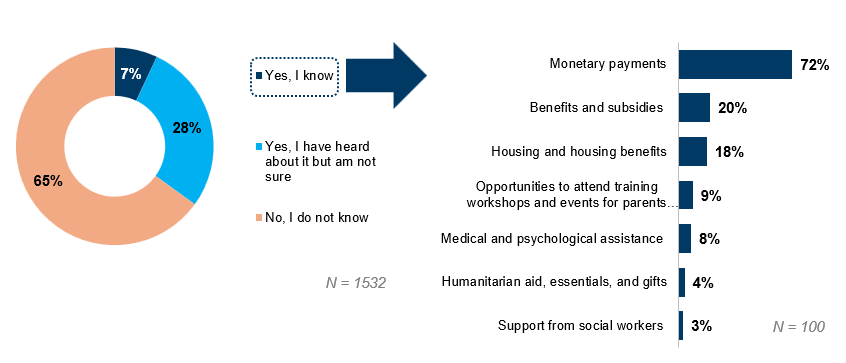
Measures to encourage adoption
We asked the respondents what measures the government could implement to encourage adoption. According to 41% of them, financial assistance is the primary way to promote adoption in Ukraine. The importance of simplifying the adoption process is highlighted by 36% of all respondents and 42% of those open to the possibility in the future.
33% of respondents support information campaigns to promote adoption, rising to 38% among those who are willing to consider adoption in the future.
28% of respondents support expanding the pool of adoptive parents, including single parents. This support is higher among people aged 18-29 (42%) and 30-44 (33%) compared to older respondents, among those with children under five years old (33%) and children aged 15-17 (34%), as well as among IDPs (35%) and single parents (46%).
Consultations and services to support foster parents are deemed important by 23% of respondents, while tax benefits are supported by 20%. Educational resources for preparing for adoption are valued by 19%, especially among younger respondents (25% of those aged 18-29).
Figure 9. Respondents’ suggestions in response to an open-ended question on improving the child adoption process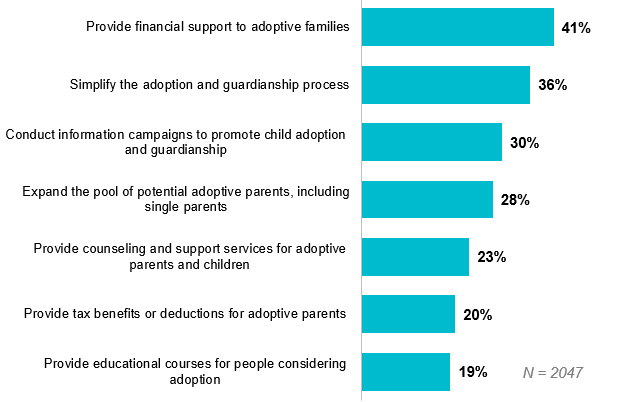
How the adoption process actually works
According to the Family Code of Ukraine (Article 211), an adoptive parent can be either a couple or a single individual who is not married. Same-sex couples are not eligible to adopt. Additionally, individuals who are legally incapacitated, deprived of parental rights, abuse alcohol or drugs, lack a permanent residence or stable income, suffer from certain mental health disorders or other severe illnesses (such as tuberculosis, leprosy, or stage four cancer), require constant care, are registered with a mental health or substance abuse clinic, or have convictions for serious crimes cannot be adoptive parents.
In Ukraine, adoptive parents must be at least 21 years old, and there must be a minimum age difference of 15 years between them and the child if the adoptive parent is not a relative. There are no restrictions on the upper age limit for adoptive parents.
Ukrainians wishing to adopt a child can submit an application to the child welfare service at their place of residence or through the “Diia” portal. The adoption application must include the following documents: a copy of the passport and tax identification number, a document with a unique number from the Unified State Demographic Register, an income certificate or declaration, a marriage certificate, a health certificate, a criminal record check, proof of housing rights, and notarized consent from the other spouse. If the adoptive parent is married, health and criminal record documents must be submitted by both spouses. Within five days, the child welfare service verifies the living conditions and organizes a training course on raising orphans and children deprived of parental care. Upon completing the training, the applicant receives a certificate valid for 24 months and is then registered for adoption. Following this, the process of matching a child with the family begins.
The decision to adopt a child is made by the court, where the adoptive parent submits the application in person. Written consent from the guardian or custodian is required if the child is under guardianship or custody. If such consent is not provided, the guardianship and custody authority or the court makes the relevant decision. For the adoption of a child who is in a healthcare or educational institution, consent from that institution is also needed, but the court can decide without it. Adoption is considered finalized once the court’s decision comes into effect. On average, the entire process of adopting a child takes about a year.
Starting from March 2024, families in the adoption process can take a child into their care before the official court decision, provided they obtain a positive assessment from the local administration and submit the appropriate application to the court.
The state provides a financial assistance payment to the family upon adopting a child, equivalent to the birth assistance amount (i.e., UAH 41,280, of which UAH 10,320 is paid as a one-time payment, and the remaining amount is distributed as UAH 860 per month over the next 36 months).
Conclusions
The survey results indicate that social services need to raise awareness about adoption. Currently, most people lack a clear understanding of the process and the available government support. Therefore, an informational campaign about government adoption programs and the support that prospective adoptive parents can receive is essential.
The main barriers to adoption are the complicated bureaucratic process and lack of financial resources. To address these issues, it is necessary to simplify administrative procedures and expand financial support for adoptive families. This could include direct financial assistance and tax benefits for adoptive parents.
Expanding adoption opportunities for various categories of potential adoptive parents, including foreigners or Ukrainians living abroad, and providing medical, psychological, and legal support during and after adoption could increase the number of adoptions. Accessible and user-friendly consultations, educational resources, and other forms of support should also be made available.
People over 45 are less likely to consider adoption. Strategies need to be developed to change perceptions about adoption across different age groups and emphasize the importance of involving individuals of various ages in the adoption process.
The presence of biological children is often a reason why people decide against adoption. Measures should be developed to encourage families with biological children to consider adoption, including financial benefits, tax deductions, and support programs. It is also crucial to continue offering medical and psychological assistance to help families adapt to new circumstances and integrate the adopted child. According to the law, social workers provide support and assistance for families with adopted children based on an individual plan, which is reviewed annually.
Фото: depositphotos.com/ua
Attention
The author doesn`t work for, consult to, own shares in or receive funding from any company or organization that would benefit from this article, and have no relevant affiliations



